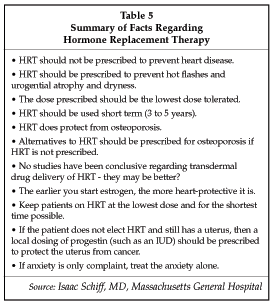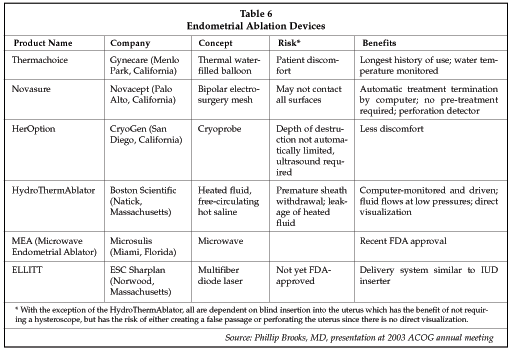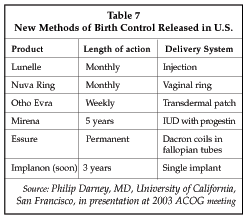BBI Contributing Editor
NEW ORLEANS, Louisiana Hormone replacement therapy (HRT) was at the top of the list in terms of interest for most of the ob/gyns attending the annual clinical meeting of the American College of Obstetricians and Gynecologists (ACOG; Washington), held here in late April and early May. When the National Institutes of Health (NIH; Bethesda, Maryland) halted the Women's Health Initiative's (WHI) long-term study examining the role of HRT in the prevention of heart disease, breast and colon cancer, and osteoporosis, patient calls came flooding into gynecologists' offices. Most gynecologists were unprepared to handle the onslaught of unanswered questions the study presented. Many delved into any information source available to determine how they would respond to their patients regarding HRT now that this study had alarmed the general public. They found it difficult to sort through the hundreds of clinical studies regarding estrogens, combination estrogen plus progesterone, heart disease protection vs. increased risk, and all the variable benefits and risks associated with HRT. Nearly a year later, ob/gyns are still trying to determine the most appropriate course of treatment for their menopausal patients.
In his talk, "A Perspective on the History of Hormone Replacement Therapy Concluding with the findings of the Women's Health Initiative," Isaac Schiff, MD, chief of Vincent Memorial ob/gyn service at Massachusetts General Hospital (Boston, Massachusetts), helped ob-gyns sort through the magnitude of clinical studies, and better understand how to relate the NIH/WHI results to their patients. He reminded the audience of how, in the 1990s, it was almost malpractice not to put all menopausal patients on estrogens. Schiff noted that now there is no simple answer that each patient must be evaluated individually, and HRT decisions need to be made jointly between the patient and her doctor, based on her specific risk-benefit needs.
The long-term risk of getting breast cancer while taking estrogens remains the No. 1 concern of patients determining whether or not to go on HRT. Schiff related the WHI statistics as being able to tell your patients that if they don't take HRT, their chance of getting breast cancer is three in 1,200, and if they take HRT the risk is four in 1,200.
The newer, second-most-voiced concern is whether or not there is an increased risk of cardiovascular events. Although the WHI study found no cardioprotective benefit with estrogen use, it only included women over 60 years of age and clearly post-menopausal; while many other studies show that by starting HRT early (i.e., perimenopausal), there is a cardioprotective benefit. While emphasizing that there is a divergence of information contained in different studies, Schiff concluded his lecture by summarizing the facts on which the WHI and other studies tend to agree (Table 5).

The intent of endometrial ablation is to preserve the uterus while treating the cause of the symptoms and to avoid a hysterectomy. Endometrial ablation procedures have grown by 35% annually from about 160,000 procedures three years ago to 400,000 procedures estimated for 2003. Even with reports stating that 20% of patients who have endometrial ablation performed eventually have a hysterectomy within five years, endometrial ablation procedures continue to grow as the choice for conservative treatment of menorrhagia other than hysterectomy. Mark Glasser, MD, of Kaiser Permanente Medical Center (San Francisco, California), found that in a study of 22 patients with intracavitory myomas, the results of the ablation treatment persisted over 36 months, with a 91% success rate and 54% of his patients reporting amenorrhea at 36 months.
Many new endometrial ablation products are now being accepted as a tool routinely used by gynecologists. Phillip Brooks, MD, clinical professor of ob/gyn at the UCLA School of Medicine (Los Angeles, California), discussed all the new devices that are replacing the older electrosurgery and laser ablation devices, which he feels are not as safe and require greater skill to use. In his presentation, "Endometrial Ablation: Traditional and Global Techniques: Results and Risks," he described the newer products and their advantages and disadvantages (Table 6 below).

Brooks said he has long believed in the conservation of the uterus, especially for conditions originating from benign sources. He said he feels that the ideal role for global ablation techniques is in an office or procedure suite without the risk of general anesthesia. This reduces the cost and anxiety to the patient and conserves time for the gynecologist. Under his protocol, his patients report a pain score of 0 by the second day and an average recovery time of 30 minutes in his office before going home. He concluded by saying that endometrial ablation procedures are effective and provide patients with better care.
"Approximately 64% of the more than 60 million U.S. women of childbearing age (15-44) use contraception, which regardless of method, all provide women greater benefits than risks. Women have had access to five new contraceptive methods in as many years," said contraception expert Philip Darney, MD, chief administrator in obstetrics and gynecology department at the University of California, San Francisco. Of the five new methods, two of them the vaginal ring and the patch were precedent-establishing in that they were first used in the U.S. (Table 7). In the past, new methods of birth control were first launched in Europe and then slowly made their way through the FDA and into the U.S. European and Chinese communities have fewer unintended pregnancies and lower abortion rates than the U.S., and Darney said he believes that this is due to the fact that the most successful contraceptive programs are those that offer the widest variety of birth control methods.

Another new method expected to gain FDA approval this year is Implanon by Organon (Oss, the Netherlands), which is a very low-dose progestin delivered as a single implant. Unlike Norplant, which contained five implants, Implanon is easy to extract and now supplies U.S. women with an additional selection of an implant if desired. Organon also is developing a hormonal contraceptive for men, trials for which are under way in Europe and the U.S. If the cafeteria approach to birth control does increase the use of contraception, then the U.S, is on its way to successfully reducing unintended pregnancies and abortions by offering a wider variety of birth control choices.
Along with a broader selection of contraception, emergency contraception (EC) is now also offered in the U.S., although not without barriers to obtaining it. Timing is critical for emergency contraception because for every 12-hour delay in starting treatment, efficacy declines by 50% and it must be taken within 72 hours of unprotected intercourse, often sooner than most women can find a physician and get an appointment.
Despite FDA approval and wide support from ACOG, access to emergency contraception is still limited in the U.S. Although 11 states passed legislation permitting women to obtain emergency contraception directly from pharmacists without first visiting a doctor or clinic, the pharmacists were not allowed to dispense the pills without physician involvement. Under new laws in those 11 states, physicians could sign protocols authorizing licensed trained pharmacists to provide EC directly to women.
This trend among state legislatures is continuing, as is a submission to the FDA to grant over-the-counter status for Plan B, an EC product marketed by Women's Capitol Corp. (Washington). "Making EC directly available to women is the best way to reduce the rate of abortions. The Alan Guttmacher Institute (New York) estimates that EC use prevented 50,000 abortions in the year 2000," Darney said.
A new book, Birth Control, a Woman's Choice, just published by ACOG and announced at this year's conference, provides an up-to-date description of all contraceptive methods.
